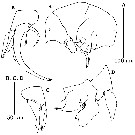|
|
 |
|
Calanoida ( Order ) |
|
|
|
Pseudocyclopoidea ( Superfamily ) |
|
|
|
Pseudocyclopidae ( Family ) |
|
|
|
Pseudocyclops ( Genus ) |
|
|
| |
Pseudocyclops sp. Chullasorn, Ferrari & Dahms, 2010 (F,M) | |
| | | | | | | Ref.: | | | Chullasorn & al., 2010 (p.36, 48, figs.M) |  issued from : S. Chullarson, F.D. Ferrari & H.-U Dahms in Helgol. Mar. Res., 2010, 64; [p.51, Fig.14, A-D]. Male (from Shedd Aquarium Chicago): A: P5 (potopod and endopods, anterior view); B, right exopod of P5 (anterior view); C, proximal segment of right exopod of P5 (posterior view); D, left exopod of P5 (anterior view). Nota: This species is similar to P. schminkei, but the distal attenuation of articulating segment 15 on right A1 of males reaches beyond segment 16 as it does for P. schminkei. The intercoxal plate of male P5 has a simple, ventral lobe (fig. A), and the distal segment of the right exopod is thick, relative to its length (fig.B, C). The proximal lobe of the distal segment of left exopod is not simply quadrate, and the distal part of the limb is broader (fig.D).
|
 issued from : S. Chullarson, F.D. Ferrari & H.-U Dahms in Helgol. Mar. Res., 2010, 64; [p.51, Fig.14, E-G]. Male: E, left exopod of P2 (middle segment and distal complex, anterior view); F, right exopod of P2 (middle segment and distal complex, anterior view); G, right exopod of P2 (lateral seta of middle segment and proximo- and distolateral seta of distal complex, lateral view). Another difference with P. schminckei: the lateral seta on middle exopodal segment of the right P2 of males is irregularly swollen (fig. E,F); the proximal seta on distal segment is curved posteriorly, and the lateral margin between tje proximal and distal lateral seta is swollen (fig.E,G)
| | | | | NZ: | 0 | | |
|
Distribution map of Pseudocyclops sp. by geographical zones
|
| | | | Loc: | | | Origin unknown, from the Shedd Aquarium in Chicago. | | | | N: | 1 | | | | Lg.: | | | (1105) F: 0,67-0,69; M: 0,67-0,69; {F: 0,67-0,69; M: 0,67-0,69} | | | | Rem.: | After Chullasorn & al. (2010, p.47) this population serve as food for larval Amphiprion spp. and juvenile Hippocampus spp. Not found for a gender-limited dimorphism among specimens. This form is similar to P. schminkei. | | | Last update : 30/01/2015 | |
|
|
 Any use of this site for a publication will be mentioned with the following reference : Any use of this site for a publication will be mentioned with the following reference :
Razouls C., Desreumaux N., Kouwenberg J. and de Bovée F., 2005-2025. - Biodiversity of Marine Planktonic Copepods (morphology, geographical distribution and biological data). Sorbonne University, CNRS. Available at http://copepodes.obs-banyuls.fr/en [Accessed December 26, 2025] © copyright 2005-2025 Sorbonne University, CNRS
|
|
 |
 |





